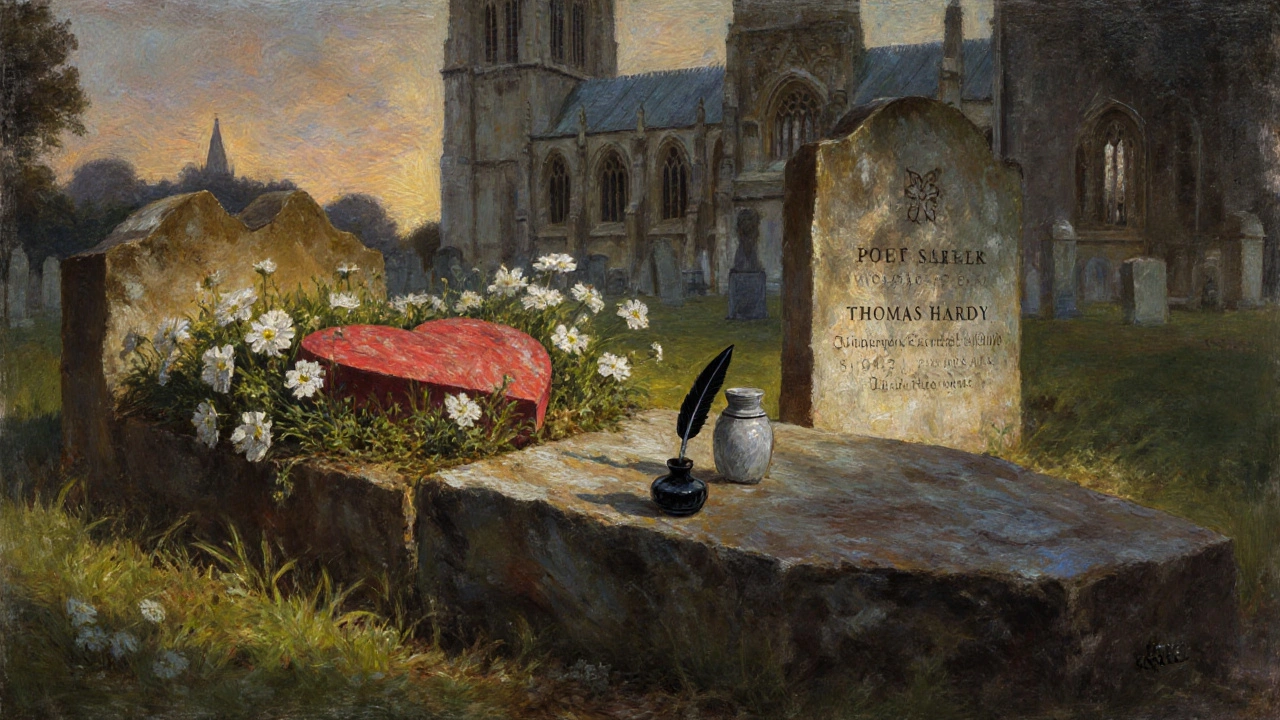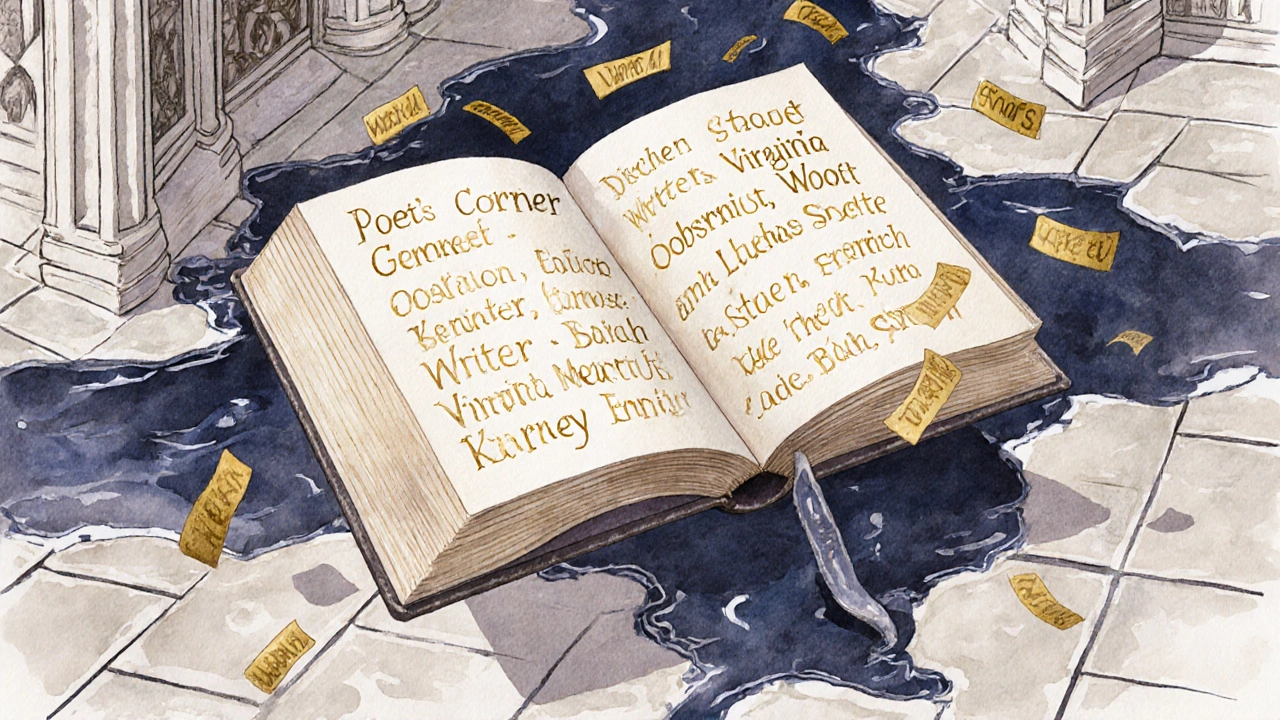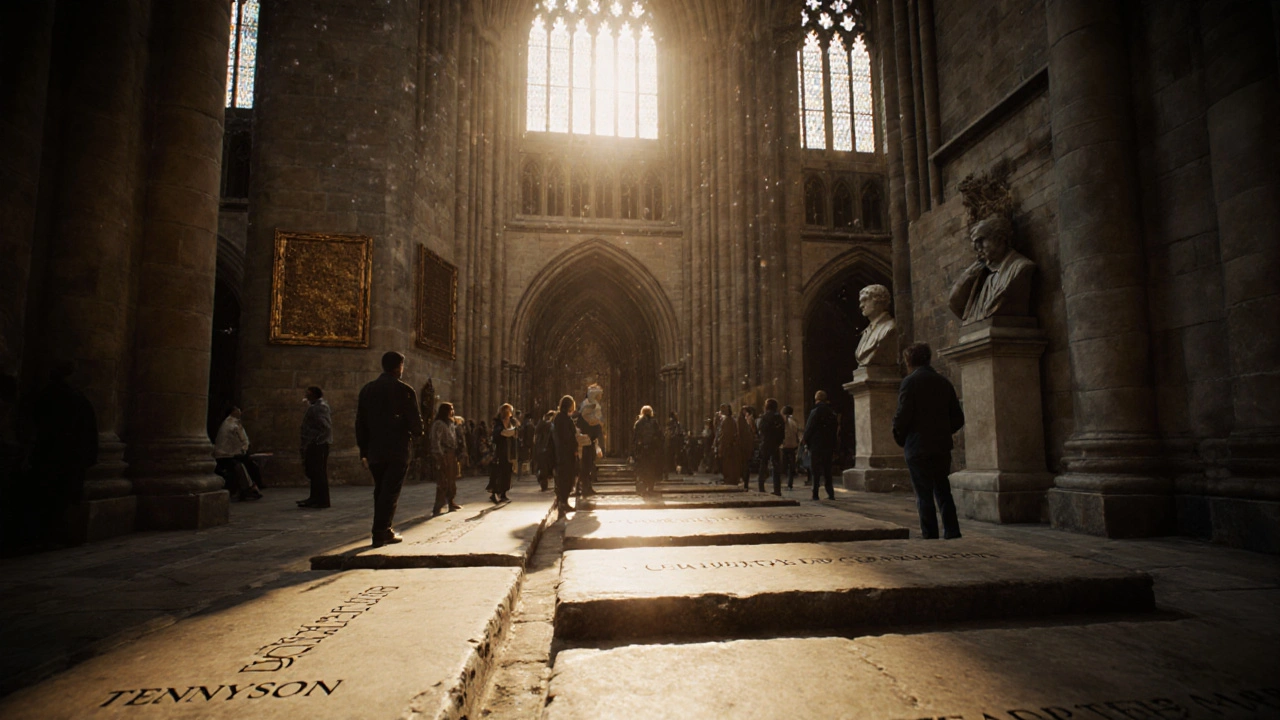Walk through the nave of Westminster Abbey and you’ll hear the quiet shuffle of tourists, the hum of a guided tour, the occasional chime of a bell. But if you pause near the southern transept-where the light falls just right on the worn stone-you’re standing on the final resting place of Britain’s most celebrated writers. This isn’t just a quiet corner. It’s Poet’s Corner, a sacred patch of ground where poetry, prose, and drama are etched into the floor, walls, and memorials of one of the world’s most historic buildings.
How Poet’s Corner Started
It began with Geoffrey Chaucer. Not because he was the first poet buried there-but because he was the first to be buried there for his writing. In 1400, Chaucer was laid to rest in the abbey’s west end, not as a nobleman or courtier, but as a man whose words had changed English literature. At the time, he was already famous for The Canterbury Tales, but his burial wasn’t meant to honor literary greatness-it was just where he lived, working as a clerk. Still, his grave became a magnet. By the 1700s, other writers started asking to be buried nearby. The tradition stuck.
By 1889, the abbey officially designated the area as Poet’s Corner. No longer just a cluster of graves, it became a curated space for literary memory. Today, more than 100 writers are honored here-not all buried in the ground, but remembered with plaques, busts, and monuments. Some are buried under the floor. Others are remembered with stone slabs you walk on every day.
Who’s Really Here?
Chaucer’s grave is the oldest, but you won’t find his original tomb. It was moved and rebuilt in the 1550s. His current marker is a simple stone slab near the east wall. Look for the carved quill and the words: “Here lies Geoffrey Chaucer, father of English poetry.”
Next to him, you’ll find the grave of Charles Dickens. He died in 1870 and was buried in the abbey’s Poet’s Corner after a public campaign. His family had wanted him in a quiet country churchyard, but the nation insisted: Dickens was too important. His simple black stone bears just his name and dates. No flourishes. No poetry. Just the truth: he changed how people read.
Then there’s Thomas Hardy. He wanted to be buried in his hometown of Dorset, but the Abbey wouldn’t let him go. So they split him. His heart was buried in Stinsford with his first wife. His ashes? In Poet’s Corner. A quiet compromise for a man who wrote about loss, love, and fate.
And then there are the names you’ll recognize from school: John Dryden, Robert Browning, Alfred Tennyson, Elizabeth Barrett Browning. All with plaques on the walls. Some with full statues. Tennyson’s bronze bust, sculpted by his son, stands near the south wall. He’s looking out, as if still watching the world he described in verse.
But Poet’s Corner isn’t just for poets. It’s for playwrights, novelists, and even screenwriters. William Shakespeare isn’t buried here-he’s in Stratford-upon-Avon. But his memorial? A full-sized marble statue, commissioned in 1741, sits near the center. It’s the only statue of a writer in the entire abbey that’s not of someone actually buried here. Why? Because even in death, Shakespeare looms too large to be ignored.
Who’s Missing-and Why
Not every great writer made it in. George Eliot (Mary Ann Evans) never got a plaque. She was a woman writing under a man’s name in the 1800s. The Abbey didn’t honor her until 2008, when a simple stone was finally placed in the floor. It’s small, unassuming. You might miss it if you’re not looking.
Virginia Woolf isn’t here either. She drowned herself in 1941. Her ashes were scattered in the River Ouse. No plaque. No monument. Some say the Abbey still holds old biases-against women, against modernists, against those who didn’t play by the rules.
Even D.H. Lawrence, who wrote about sex, class, and nature in ways that shocked his time, was left out for decades. His memorial came in 1980, nearly 50 years after his death. It’s a modest stone, placed near the back wall. You can still read his famous line: “I never saw a wild thing sorry for itself.”
It’s not just about fame. It’s about who the establishment decided deserved to be remembered. And that’s changed slowly, painfully, over time.

The Modern Poet’s Corner
Things are shifting. In 2018, John Betjeman got a new stone. He was a poet, yes-but also a broadcaster, a preservationist, and a voice for England’s lost churches. His memorial was the first to include a quote from his own writing: “I am not a poet, I am a man who writes poems.” Simple. Human.
In 2022, the Abbey added a plaque for Zadie Smith. She’s the first living Black British woman writer to be honored in Poet’s Corner. Her name isn’t on the floor yet. But a brass plaque now hangs on the wall, next to Tennyson’s. It reads: “Zadie Smith, novelist, essayist, 1975-.” The dash at the end? Intentional. She’s still writing.
The Abbey isn’t just a museum anymore. It’s a living archive. Writers who once would have been excluded are now being added-not because they’re dead, but because their work matters now. And that’s the point.
What It Feels Like to Stand There
Go early. Before the crowds. Stand in front of the stone that marks the grave of Ben Jonson, who wrote in the 1600s and was buried in the floor because he couldn’t afford a monument. His marker says: “O rare Ben Jonson.” Just those three words. No title. No rank. Just “rare.”
Walk slowly. Run your fingers along the edge of the stone slabs. Some are smooth from centuries of footsteps. Others are cracked, weathered, barely legible. You’re walking over the bones of people who changed the language you speak.
Look up. The walls are covered in names you know and names you’ve never heard. A 19th-century novelist. A forgotten war poet. A playwright from the 1700s. A modern novelist who wrote about migration and identity. They’re all together now. No hierarchy. No royal blood. Just words that lasted.
It’s not a tomb. It’s a conversation.

Why This Matters Today
Books are everywhere now. You can download a Shakespeare sonnet on your phone. You can hear a poem read by a stranger on YouTube. But standing in Poet’s Corner reminds you that words once cost something. They cost time. They cost courage. They cost a life.
These writers didn’t write for likes. They wrote because they had to. Because the world was too loud, too cruel, too beautiful to stay silent. And now, centuries later, their words are still here-etched in stone, underfoot, in the quiet corners of a 1,000-year-old church.
Poet’s Corner isn’t about death. It’s about what survives. A line of verse. A character’s last breath. A truth spoken when no one else dared.
It’s the reason people still come here-not just for the architecture, not just for the royal coronations-but to touch the same stones that held the pens of the people who taught us how to feel.
Is Poet’s Corner only for poets?
No. While it started with poets, Poet’s Corner honors novelists, playwrights, essayists, and even screenwriters. Charles Dickens, George Eliot, and Zadie Smith are all buried or memorialized here, even though they wrote fiction, not verse. The only requirement is that their work had a lasting impact on English literature.
Can anyone be buried in Poet’s Corner?
Not exactly. Burial space is extremely limited. Most modern honorees get a memorial plaque on the wall or floor, not a burial plot. The Abbey selects writers based on their contribution to English literature, not popularity or fame. The process is managed by the Dean and Chapter of Westminster, often with input from literary scholars and public nominations.
Why isn’t Shakespeare buried in Poet’s Corner?
Shakespeare was buried in Holy Trinity Church in Stratford-upon-Avon, as per his will. His memorial in Westminster Abbey-a full-size statue commissioned in 1741-was added later as a tribute. He’s the only major writer honored with a statue in the Abbey who isn’t buried there, because his grave was already sacred in Stratford.
Are there any women in Poet’s Corner?
Yes, but historically, very few. Elizabeth Barrett Browning was the first major female poet honored with a floor slab in 1861. George Eliot got a memorial in 2008, and Zadie Smith became the first living Black British woman writer to be honored with a wall plaque in 2022. The Abbey has been slowly correcting its past omissions.
Do you need a ticket to see Poet’s Corner?
Yes. Poet’s Corner is inside Westminster Abbey, which is an active church and a tourist site. You must buy a ticket to enter the abbey. There’s no separate fee for Poet’s Corner-it’s included in the general admission. Free entry is only granted for worship services, but you won’t be able to explore the full abbey then.
What to Do Next
If you’re in London and want to visit Poet’s Corner, plan ahead. The Abbey opens at 9:30 a.m. on weekdays and 10 a.m. on weekends. Go early to avoid crowds. Bring a notebook. There are no signs telling you who’s where-you’ll need to find the names yourself. Look for the small brass plaques, the carved stones, the silent busts. Take your time.
Afterward, walk down to the River Thames. Stop at the South Bank. There’s a bench near the National Theatre where you can sit and read a poem by one of the writers you just visited. Maybe Tennyson. Maybe Woolf. Maybe Smith. Let their words follow you out of the abbey and into the city.
Because Poet’s Corner isn’t just a place. It’s a promise: that words outlive bodies. And that if you write something true, someday, someone will stop and read your name on the stone.
